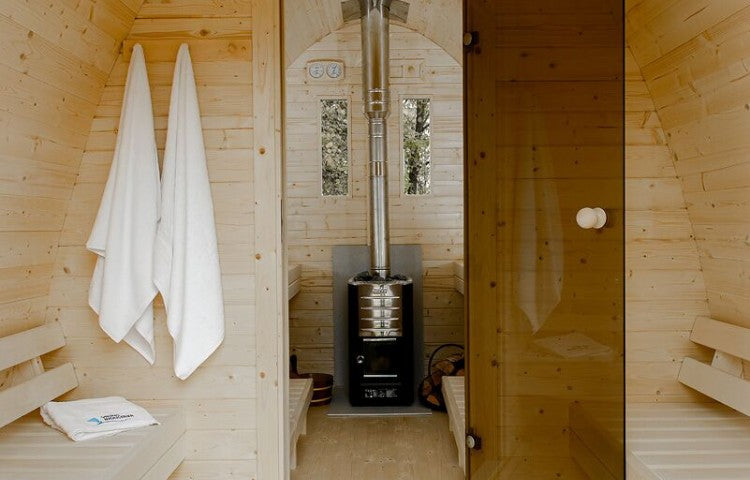Thinking of turning your living room into a wellness retreat? Infrared Sauna vs Red Light Therapy might have you sweating—literally. Short answer: Infrared Saunas (like a cosy Home Sauna or Garden Sauna) are for full-body detox; Red Light targets healing. Keep reading to find your perfect Outdoor Sauna vibe!

Key Differences and Similarities
Mechanisms of Action
Heat Generation (Red Light Therapy: No heat; Infrared Sauna: Heat-inducing)
Infrared saunas use heat to warm the body from the inside out. This often leads to heavy sweating and an increase in core temperature. In contrast, red light therapy delivers low-level light that doesn’t heat the body. Instead, it interacts with cells to promote healing.
Light Wavelengths and Penetration Depth
Red light typically operates between 600–700nm wavelengths. This range reaches skin-level tissues. Infrared light extends deeper, between 700–1000nm, affecting muscles and internal systems. This deeper penetration sets infrared saunas apart for full-body effects.
Cellular vs. Whole-Body Impact
Red light therapy focuses on stimulating cells—especially mitochondria—in specific areas. Infrared saunas work systemically, benefiting multiple systems like cardiovascular, lymphatic, and muscular all at once.
Benefits: Targeted vs. Holistic

Red Light Therapy Benefits
-
Skin Health & Collagen Boost
-
Pain Relief & Reduced Inflammation
-
Wound Healing Support
-
Improved Mood & Cognitive Balance
-
Hair Growth Enhancement

Infrared Sauna Benefits
-
Sweat-Driven Detoxification
-
Muscle & Joint Recovery Support
-
Cardiovascular & Circulatory Improvement
-
Stress Relief & Mental Calm
-
Potential Calorie Burn & Weight Loss Aid
Usage, Accessibility, and Considerations
Session Duration and Frequency
Infrared sauna sessions typically last 20–40 minutes. Red light therapy can be as short as 10–20 minutes, depending on the device and area treated. Most users benefit from 3–5 sessions per week.
At-Home vs. Professional Use
Both treatments are now available for home use. Home saunas, garden saunas, and outdoor saunas are increasingly popular. Red light devices are also widely available for issues like facial rejuvenation or joint pain.
Cost and Investment
Red light devices range from £100–£1000 depending on size and quality. Infrared saunas usually start at around £1500 and can reach £5000+, especially for custom outdoor sauna setups.
Safety and Precautions
Red light therapy is generally safe, though overexposure may irritate the skin or eyes—eye protection is recommended. Infrared saunas require proper hydration and awareness of heat stress, especially for those with cardiovascular concerns.
Which One is Right for You? (And Can You Combine Them?)
Choosing Based on Your Wellness Goals
For Skin Rejuvenation
Red light therapy is ideal due to its collagen-stimulating effects. It can help reduce fine lines and inflammation.
For Deep Detoxification
Infrared sauna is best for detox—inducing sweat helps release toxins and supports lymphatic drainage.
For Targeted vs. Full-Body Pain Relief
Use red light for localised pain like knees or shoulders. Choose infrared sauna if you're seeking relief from full-body muscle tension or general aches.
For Relaxation and Stress Reduction
Both therapies help reduce stress. However, infrared saunas provide a more immersive and meditative experience.
For Athletic Recovery and Performance
Infrared saunas are a popular post-workout choice to speed recovery. Red light is effective for treating sore spots or small injuries.
Combining Therapies for Enhanced Benefits
Synergistic Effects
Pairing both therapies can enhance outcomes. Use infrared saunas to warm muscles, boost circulation, and encourage detox. Follow up with red light to treat specific concerns such as ageing skin or joint discomfort.
Practical Application (e.g., sauna first, then RLT)
Many suggest using the sauna first. This opens pores and promotes blood flow, allowing red light to better penetrate tissues and support healing.
Takeaways
-
Red light therapy is targeted, gentle, and skin-deep.
-
Infrared saunas offer full-body benefits through heat.
-
Both improve pain, mood, and recovery—just in different ways.
-
For best results, combine both smartly.
Conclusion
When it comes to infrared sauna vs red light therapy, there’s no clear winner. Each has its strengths—whether you're aiming for glowing skin or deep muscle relief. Thanks to the rise in home saunas and red light devices, you can now tailor your wellness setup to meet your personal goals.






